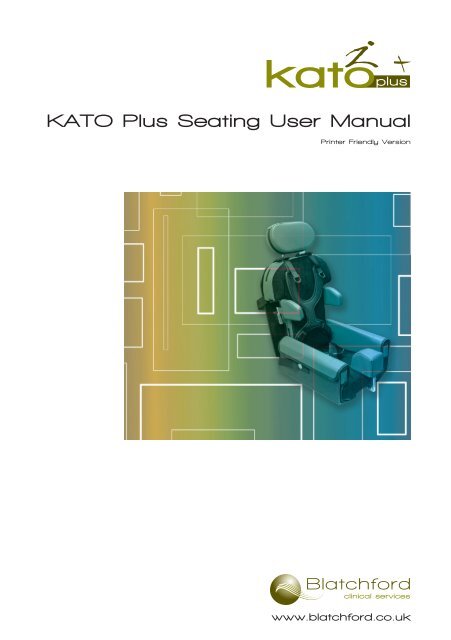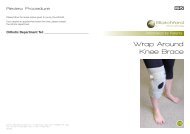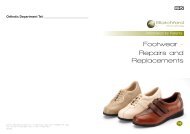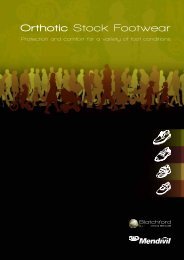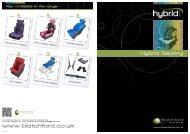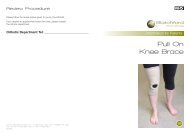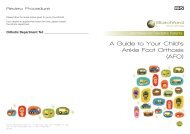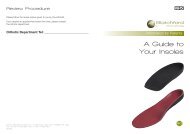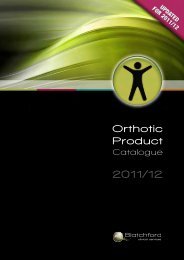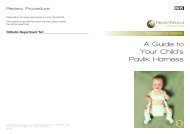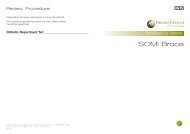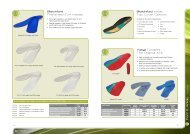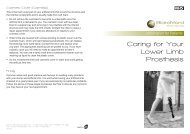kato katoplus - Blatchford
kato katoplus - Blatchford
kato katoplus - Blatchford
- No tags were found...
You also want an ePaper? Increase the reach of your titles
YUMPU automatically turns print PDFs into web optimized ePapers that Google loves.
<strong>kato</strong> plusKATO Plus Seating User Manual<strong>kato</strong>Printer Friendly Versionstarterwww.blatchford.co.uk 1
<strong>kato</strong> plusKATO Plus User Manual<strong>kato</strong> starterIntroduction 2Pre-use Checks 2Fitting the Kato Seat Insert into the Host Wheelchair 4(including Multi Adjustable interface instructions)Specialist Wheelbases 4AdjustmentsHeadrest 6Thoracic & Hip Supports 6Abduction Block (pommel) & Knee Block 7Seat Depth 7Footrest 8User Instructions: Posture Belt & Posture Harness 8User Instructions: Moulded Trays 9User Instructions: Moulded Sandals and Footstraps 10User Instructions: AEL Mounting Kit 11Looking After Your Kato Seat 12Cleaning Instructions 12Transportation in a Motor Vehicle 13Important Reminders 14Further Information 14Notes & Manufacturer’s Label 15PageIntroductionThe Kato + seat is a custom-made device and it should only be used by the person it wasmade for.This User Manual gives important safety advice as well as giving information about making basicadjustments and caring for the Kato. (Any other mechanical adjustments or maintenance mustonly be carried out by your Wheelchair Service or by <strong>Blatchford</strong> Clinical Services).Pre-use Checks (fig. 1)Before using your Kato seating system, please check the following:• The two retaining straps should be securely fastened (see fig. 1 and ‘fitting of Kato seatto host wheelchair’ on the next page). This check must be carried out every time theequipment is dismantled and assembled.• All user support items (for example pelvic straps, a butterfly harness or footstraps)should be securely fastened.If you are not sure how to do any of these things please contact your Wheelchair Service.2 3
Fitting the KATO Seat Insert intothe Host WheelchairNote : yourseat may onlyhave onestrapfig. 1BAIS - <strong>Blatchford</strong> AdaptiveInterface SystemComponents:A. InterfaceB. Latch ClampsC. Seating Attachment A B CFitting the Interface to the Wheelchair (Applies to folding wheelchairs only)1 42 31. Wheelchairs Complete with Base and Back Canvas (fig. 1)• Remove armrests from host wheelchair to improve access.• Place Kato seat onto wheelchair canvas.• Pass the two retaining straps around the wheelchair uprights (make surethey are not tangled or obstructed).• Push both ends of the buckle together to secure.• Tighten both straps by pulling the loose endof the webbing away from the buckle.• If the Kato is fitted with a tube on the rear of thebackrest (see fig. 2) make sure that the U shapedfig. 2brackets (A) fasten around the push handles ofthe wheelchair (B). Reverse the process to remove the Kato seat from the wheelchair.1. Ensure that the wheelchair is fully open.2. Check that the latches are in the open position. (fig1)3. Position the interface hooks, ensuring that on each side one hook is behind and one hookis in front of the clamps. (fig 2&3)4. Slide the latch clamps so that the tongue is over the top of hooks. (fig 4)5. Check that the interface is correctly located by attempting to lift it out (a small amount ofmovement is normal).6. To remove the interface, slide the latches back and lift the interface upward.Attaching the Seating Systemto the Interface51. Taking care when lifting, position theseat onto the interface and locate thefront hook onto the front bar. (fig 5)2. Allow the seat to tilt backwards anddown, pressing it firmly into place.A click will be heard as the locks engage.3. Check that the pins have fully located by pulling the seat forward, (a small amount ofmovement is normal). However, the seat should not lift forward.4. Repeat stages 1 – 4 if the seat lifts from the interface.Removing the Seating System from the Interface1. Undo or disconnect and backrest fixings.2. Pull “D” ring (fig 6, located under the front of the seat)firmly and lean the Seating System forward.3. Taking care, lift the Seating System upward and clear fromthe wheelchair.4 56
Adjusting the HeadrestThe headrest can be moved both up and down and frontto back (fig. 3). The angle of the support can also be setto get the best position.• To adjust the headrest height, turn the locking knob (A)anticlockwise. Alter the height to suit the user andretighten the knob.• To adjust the head support in or out, turn the lockingknob (B) anticlockwise. Alter the position of theheadrest to suit the user and retighten the knob.To adjust the angle of the headrest (C) please consultyour Wheelchair Service.fig. 3Note : the headrest must be in place during the transportation of the user inthe Kato (see page 9 for more information).Using the Thoracic and Hip SupportsAdjusting Thoracic SupportsThe thoracic pads are set to suit the postural needs of the user. If you feel that the setting of thepads carried out at the delivery is no longer suitable please contact your Wheelchair Service.Swing Away Function (fig. 4)• Lift the thoracic pad upwards as faras it will go (A).• Swing away the pad as shown (B).• Reverse the process to return thesupport towards the user.fig. 4Hip Supports• Lift the Velcro side flaps up at each side of the system.• Remove/add padding from each side as required (ensure each side is adjusted evenly).• Replace the flaps to protect the supports.The Abduction Block (pommel) orKneeblock (fig. 5) (if fitted)• Slide the end of the square tube into the bracket,until it will not go any further (the kneeblock shouldnot be in contact with the users knees at this point).• Hold the pommel or kneeblock and push thebutton on the right of the square tube.• The pommel or kneeblock can now be pushed inuntil the button locates into the hole of the locationbracket, securing the pommel or kneeblock inposition. (The knee block should now be in fullcontact with the users knees).• Reverse this process to remove.Pommels and kneeblocks are set up to meet the clinical needs of the user. The position ofthese parts should not be changed. Any problems should be brought to the attention of theWheelchair Service.A risk assessment should be carried out in order to ascertain whether ornot the kneeblocks should be removed during transportation.Adjusting the Seat Depth (fig. 8)The seat depth can be altered to allowfor growth.• To change the depth, remove thefront back pad (A), which is attachedwith Velcro, from the remainingback pad.• If a sacral pad is fitted remove thisalso (B).• Now remove the remaining back padfrom the plastic backrest (this is alsoattached with Velcro)fig. 8• Re-attach the sacral pad and the firstback pad (A) to the plastic backrest.The seat will now have 25mm more depth (the other pad is no longer needed).fig. 5If you feel that the seat depth is still not suitable please contact your WheelchairService as further adjustments can be arranged.6 7
Adjusting the Footrest (if fitted)Footrest 1 (fig. 6)(for seating systems used in a standard wheelchair)To adjust the height of the footrest:• Undo the two locking knobs at the rear of the footrest (1).• Move the footrest to the correct height and re-tighten both knobs.To remove the footrest for storage:• Using each hand, push & hold the two securing buttons (2).• Gently pull the footrest towards you for complete removal.Footrest 2 (fig. 7)(for seating systems fitted to shadows or buggies)To adjust the height of the footrest:• Undo the locking knob(s) at the rear of the footrest (A).• Move the footrest to the correct height and re-tighten thelocking knob(s).To remove the footrest for storage:• Loosen the locking knob (B) and pull the footrest away fromthe seat.• Reverse the process to re-attach.fig. 6fig. 7Posture Belt & Posture Harness -User InstructionsUsing a harness:• Do the bottom straps up first ensuring the harnessis away from the user’s neck.• Do the top straps up by clicking the male buckle into theattached female buckle of the harness.• Adjust the top straps by pulling the ‘D’ loop forwardand down whilst holding the shoulder of the user inthe desired position.For Belts & Harnesses, always make sure that:• Straps are not twisted.• Buckles are adjusted so that when they are fastened together there is no slack in the strap.CleaningThese items should be wiped clean using a damp cloth using only a mild detergent.(PLEASE DO NOT use bleach or products containing bleach).A soft brush can be used to remove heavier soiling.Safety Instructions<strong>Blatchford</strong> posture belts and harnesses are designed to provide postural support and areintended to be used as part of a specialised seating system. The belt or harness should befitted to the seat and adjusted at the time of delivery. Replacements must only be fitted by<strong>Blatchford</strong> or a Wheelchair Service representative.Important Safety WarningsPOSTURAL HARNESSES AND BELTS ARE NOT DESIGNED TO BE USED ASSAFETY DEVICES AND MUST NOT BE USED AS VEHICLE RESTRAINTS FOR USE INTRANSPORTATION.A suitable, separate, 3-point passenger seat belt (fastened into the vehicle) must be usedto secure the seated occupant during travel in order to provide protection in the eventof an accident. The seatbelt should have both pelvic and upper body sections, with theupper section fastened into the vehicle at the upper level. This should be in accordancewith Medical Device Report – Guidelines for transporting children in special seats.ALWAYS CHECK THAT THE BELT IS A SNUG FIT. CHEST BELTS SHOULD ALWAYSBE FASTENED AROUND THE OCCUPANT’S BODY AND UNDER THE ARMS. IT ISNOT INTENDED THAT THE ARMS SHOULD BE INCLUDED WITHIN THE BELT.If the hip belt is incorrectly adjusted there is a risk of the wheelchair occupant slippingdown in their seat and could result in occupant’s upper body and neck coming intocontact with the belt.If you are unsure about any of these instructions or if you are worried about theadjustment of the belt contact your Wheelchair Service.Moulded Trays - User InstructionsMoulded Trays are designed to provide a work or play surface together with supportand control in conjunction with any seating arrangement.Using the tray1. Ensure that the two vertical stems on the underside of the tray are securelylocated in the wheelchair location points.2. To fine tune the position of the tray in relation to the user, the locking knobs on theunderside of the tray must be loosened to allow the tray to be moved forwards orbackwards into the desired position. Re-tighten the locking knobs after adjustment.• Buckles are fully locked together.Width adjustment• Each end of the belt or harness is still securely attached to the seating system or wheelchair.To change the width of the tray fittings to suit an alternative wheelchair;• Buckles or webbing do not show signs of excessive wear –1. Turn the tray over and loosen the four screws using a large flat bladed screw driverif you are concerned about the condition of any items contact the wheelchair service.(do not remove the screws completely).8 9
2. Slide the adjustment tubes out/in to the desired width, ensuring that they remain parallel.3. Re-tighten the screws.AEL Mounting Kit - User InstructionsCleaningA damp, soapy cloth can be used to clean the tray surface.Warnings• ON NO ACCOUNT SHOULD ANY HOLES BE DRILLED INTO THE TRAY TOP.• ENSURE ALL LOCKING KNOBS ARE SECURE BEFORE USE.• THE TRAY MUST BE REMOVED BEFORE TRANSPORTATION.Moulded Sandals & Footstraps -User InstructionsMoulded Sandals and Footstraps are designed to provide support and control inconjunction with any seating arrangement.Do:• Ensure that straps are not twisted.• Ensure that buckles are adjusted so that when theyare fastened, there is no slack in the strap.A B CThe AEL Mounting Kit is made up of the components shown above (figs. A, B & C). Theseare not user adjustable components and therefore should not be altered in anywayby the user or carers.A & B are screwed together with the supplied fittings and attached to the back of the seatingsystem backrest (fig. D) or to the bottom of the seating system seat base (fig H).Component C is fitted to either the backrest posts or the seat rail tubes of the wheelchair.To attach the seat to the wheelchair, it is necessary to press (firmly) the hook part onto thetube as shown in fig. E & F next to the locating latches (fig C).Once correctly located the latch can then be moved over the hook and hence preventing itfrom being removed, as shown in fig. H. This should be completed for all locating latches.The backrest or seat base is now securely attached to the wheelchair.CareCheck that buckles and straps do not show signs of excessive wear or fraying - if you areconcerned about the condition of any item refer to your seating technician at the clinic orthrough your supplier as soon as possible.CleaningThese items can be wiped clean using a damp, soapycloth. A soft brush can be used to remove heavier soiling.DEF G HWarningTHIS DEVICE IS NOT DESIGNED FOR USE AS PART OF A SAFETY RESTRAINTSYSTEM FOR TRAVEL IN A VEHICLE.10 11
Looking After Your Kato SeatRoutine MaintenanceThe following checks should be carried out by the carer on a continuous basis to ensure thesafe and comfortable use of the seat.• Check there is no damage to the two retaining straps and that they are tight when fastened.• Check there is no damage to the user supports and straps e.g. pelvic straps, butterflyharness or footstraps.• Check all buckles are fastening securely.• Check that all adjustable brackets (for example, thoracic pads, kneeblocks, pommel,headrest and footrest brackets) are able to move freely when operated or adjusted.• Check the upholstery on the Kato seat is not damaged or torn as this could causelocalised skin marking to the user or general discomfort.Inspection and Maintenance by the Wheelchair ServiceIn addition to the routine checks by the carer the Kato seat should be inspected by theWheelchair Service or by <strong>Blatchford</strong> Clinical Services to make sure that the seat continues tobe safe to use and to make sure that it is still suitable for the needs of the user.These checks should make sure that all the parts of the Kato are working properly and thatthere are no signs of damage that could affect the safety of the seat and its user.Cushions and covers should also be examined to make sure that there are no sharp edges ortears that could cause harm to the user.If any problems are identified arrangements should be made for these to be correctedimmediately.The Wheelchair Service should decide how often these checks should be madetaking into account the needs of the user and the intended usage level of the seat.It is recommended that the interval between these checks should be no more than24 months.Cleaning InstructionsAll of the upholstered items can be taken off the plastic seat shell of the Kato for ease ofcleaning. Peel away those items attached with Velcro or undo zips where these are fitted.Mild CleaningFor mild cleaning a soft brush applied gently to the soiled area should help remove any dirt.For large areas a damp soapy cloth may also be used. Only use mild detergents. Allow todry before re-use.VinylAlthough the vinyl covers are removable they should not be washed in a washingmachine. To clean the upholstery, wipe a soapy cloth over the soiled areas as required. Allowto dry before re-use.Dartex Fabric (where fitted)If there is a foam section in your seat that is covered with Dartex, please follow theinstructions for cleaning as described in the Vinyl section. The foam inside this cover will besealed within a waterproof clear liner. This liner can be cleaned by wiping it with a soapy cloth.The foam should be left sealed within the liner.Terry TowellingThe covers should be washed at 30˚C maximum. At the end of the washing cycle the coversshould be placed in a warm environment and allowed to dry naturally. DO NOT tumble dry orbleach the covers (bleach will damage the material and tumble drying may cause it to shrink).Plastic Seat ShellA damp non-soapy cloth should be used to clean the main plastic surfaces of the seat bothinside and out.Transportation in a Motor VehicleNOTE: • The Kato seat must not be used as a car safety seat.• The Kato is designed to allow the seat and its user to be transported in a forwardfacing position in a vehicle designed for the purpose (for example, in a suitablyequipped minibus).• <strong>Blatchford</strong> Special Seating products are interfaced using BAIS, which conformswith ISO16840.Transportation - Essential Safety Information. NOTE: this information shouldbe passed on to those people making transport arrangements (e.g. schools andother organisations).Securing the user, the Kato seat and the host wheelchair in a vehicle:1. During travel the Kato must be securely fastened into its wheelchair as described earlier inthis manual. If the Kato is fitted into a wheelchair with a reclining backrest the backrestshould be in the upright position during travel.2. Posture belts and postural harnesses supplied as part of the seating system are designedto give postural support only. Where these items are fitted they should be used duringtravel but they must not be used as the only safety restraints.3. The wheelchair itself must be fastened down in the vehicle – this must be inaccordance with the wheelchair manufacturer’s instructions. (The wheelchairmanufacturer will issue these instructions separately. In case of query contact theWheelchair Service).4. A suitable, separate, passenger seat belt (fastened in to the vehicle) must be usedby the occupant during travel. In order to achieve occupant restraint and optimumprotection in a crash situation the seatbelt should have both pelvic and upperbody sections (for example a 3 point type with the upper section fastened into thevehicle at the upper level) as a minimum standard.12 13
Chas A <strong>Blatchford</strong> & Sons Ltd, 11 Atlas Way, Atlas North, Sheffield, S4 7QQ.Tel: +44 (0) 114 2637900 Fax: +44 (0) 114 2637901 Email: clinicalservicesales@blatchford.co.uk960432 0113PFV Iss116


